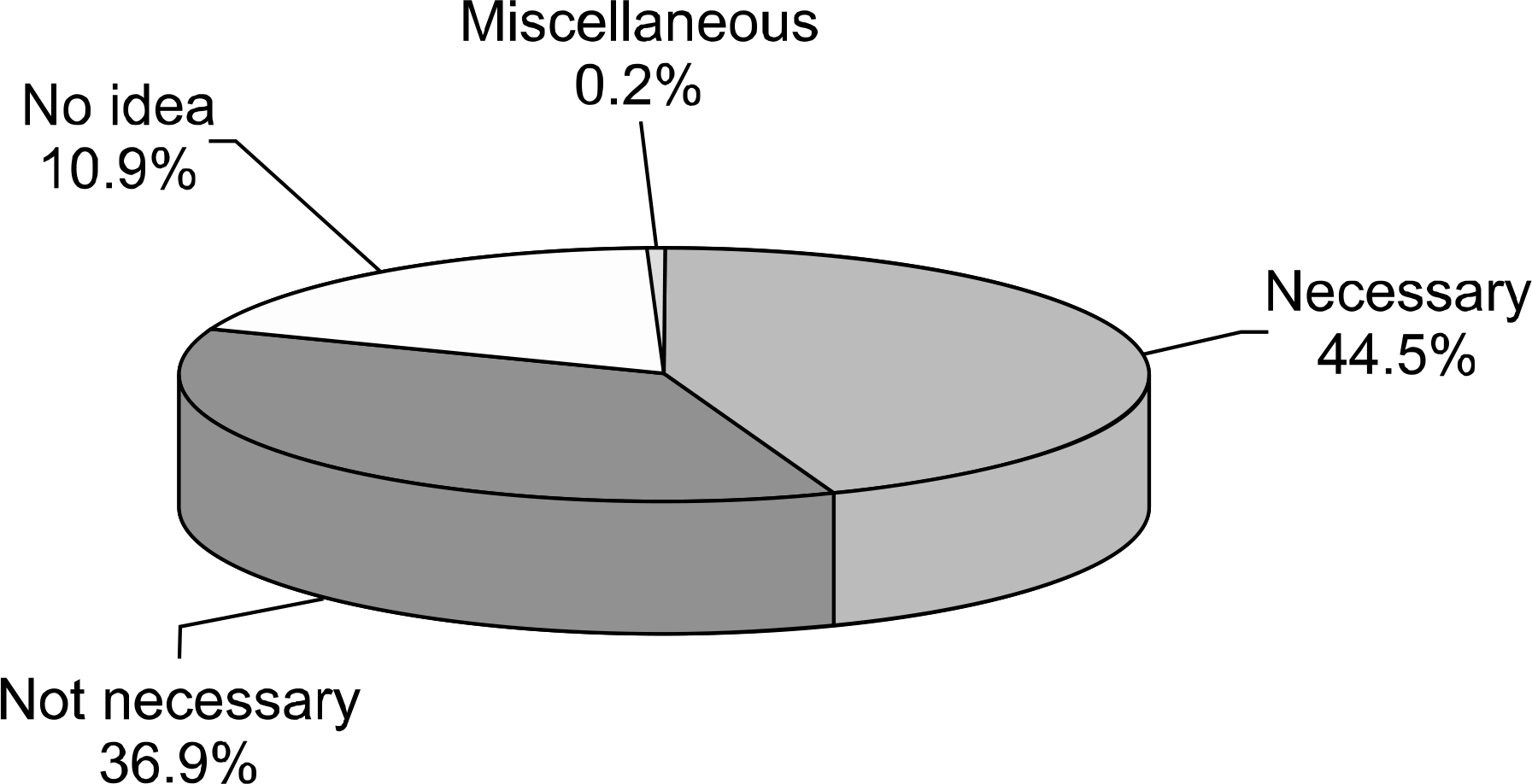Abstract
Purpose
Circumcision is widely practiced in Korea, but its implementation is still controversial, especially among younger parents. Using a questionnaire study, we tried to determine the rate of circumcision among elementary school boys and to determine parental concerns about phimosis and circumcision. We then compared our findings with previously published literature.
Materials and Methods
Between May and June 2007, we randomly selected five elementary schools and distributed self-administered questionnaires to the parents of 2,712 boys from these schools. Questions were related to children's circumcision status, age at the time of circumcision, and opinions concerning circumcision, such as its necessity and benefits. Completed questionnaires were collected and analyzed.
Results
The response rate was 66.2%. The overall circumcision rate of boys in elementary school was 15.4%. Some 40.3% of those boys underwent circumcision in the neonatal period, and 37.3% underwent the procedure between ages 9 and 12 years. The circumcision rate was significantly higher in boys in the higher income bracket group (29.5%) compared to boys in the middle and low income bracket groups (15.4% and 12.8%, respectively). Most boys were circumcised based on the intent of their parents (64.2%). Some 44.5% of parents believed that circumcision was necessary, while 36.3% of parents believed it was not necessary. The most common motive for circumcision was “hygiene benefits” (80.2%).
Go to : 
REFERENCES
1. Wisewell TE, Hachey WE. Urinary tract infections and the uncircumcised state: an update. Clin Pediatr. 1993; 32:130–4.
2. Oh SJ, Kim KD, Kim KM, Kim KS, Kim KK, Kim JS, et al. Knowledge and attitudes of Korean parents towards their son's circumcision: a nationwide questionnaire study. BJU Int. 2002; 89:426–32.

3. Kim KK. Epidemiologic study on phimosis and circumcision in elementary school boys (I). Korean J Urol. 1997; 38:1103–8.
4. Moses S, Bailey RC, Ronald AR. Male circumcision: assessment of health benefits and risks. Sex Transm Infect. 1998; 74:368–73.

5. Leitch IO. Circumcision. A continuing enigma. Aust Paediatr J. 1970; 6:59–65.
6. American Academy of Pediatrics. Report of the task force on circumcision. Pediatrics. 1989; 84:388–91.
7. No author listed. The case against neonatal circumcision. Br Med J. 1979; 1:1163–4.
8. Circumcision policy statement. American Academy of Pediatrics. Task force on circumcision. Pediatrics. 1999; 103:686–93.
9. Kim TH, Oh SJ, Choi H. Knowledge and attitude toward circumcision in Korean: a questionnaire study for adult males stratified by age. Korean J Urol. 2002; 43:786–94.
10. Ku JH, Jeon YS, Kim ME, Lee NK, Park YH. Questionnaire study about circumcision performed in young men in Daejeon city and Chung-nam area. Korean J Urol. 2002; 43:526–30.
11. Ryu SB, Kim KW, Kwon DD. Study on consciousness of Korean adults for circumcision. Korean J Urol. 2003; 44:561–9.
12. Lee SD, Park E, Choe BM. Parental concerns on the circumcision for elementary school boys: a questionnaire study. J Korean Med Sci. 2003; 18:73–9.

13. Jin OH, Kim JH, Rha KH, Kweon DH, Lim DS, Kim BH, et al. Rate of circumcision according to age: epidemiologic study in the area of Namhae, Kyoung-nam. Korean J Urol. 2001; 42(Suppl):): 202.
14. Sim KS, Seo YJ, Lee SD. Epidemiologic study on the circumcision: the viewpoints of elementary school boy's parents in Busan. Korean J Urol. 2001; 42(Suppl):): 56.
15. Cherpes TL, Meyn LA, Krohn MA, Hillier SL. Risk factors for infection with herpes simplex virus type 2: role of smoking, douching, uncircumcised males, and vaginal flora. Sex Transm Dis. 2003; 30:405–10.
16. Schoen EJ, Oehrli M, Colby C, Machin G. The highly protective effect of newborn circumcision against invasive penile cancer. Pediatrics. 2000; 105:E36.

17. Castellsague X, Bosch FX, Munoz N, Meijer CJ, Shan KV, de Sanjose S, et al. Male circumcision, penile human papillomavirus infection, and cervical cancer in female partners. N Engl J Med. 2002; 346:1105–12.

Go to : 




 PDF
PDF ePub
ePub Citation
Citation Print
Print




 XML Download
XML Download